Transcriptome Analysis and Identification of Chemosensory Genes in the Galleria mellonella Larvae
Simple Summary
Abstract
1. Introduction
2. Materials and Methods
2.1. Insect Rearing and Tissue Collection
2.2. RNA Extraction and cDNA Library Construction and Functional Annotation
2.3. Identification and Characterization of Putative Chemosensory Genes
2.4. Phylogenetic Analysis of Chemosensory Genes
2.5. Expression Analysis of Chemosensory Genes
3. Results
3.1. Overview of Transcriptome
3.2. Identification and Analysis of Candidate Chemosensory Genes
3.2.1. Identification of Candidate OBPs
3.2.2. Identification of Candidate CSPs
3.2.3. Identification of Candidate ORs
3.2.4. Identification of Candidate IRs
3.2.5. Identification of Candidate GRs
3.2.6. Identification of Candidate SNMPs
3.3. Validation of DEGs by RT-qPCR
3.4. Tissue-Specific Expression Profiling of the Candidates Chemosensory Genes
4. Discussion
5. Conclusions
Supplementary Materials
Author Contributions
Funding
Data Availability Statement
Conflicts of Interest
References
- Mora, C.; Tittensor, D.P.; Adl, S.; Simpson, A.G.B.; Worm, B.; Mace, G.M. How Many Species Are There on Earth and in the Ocean? PLoS Biol. 2011, 9, e1001127. [Google Scholar] [CrossRef] [PubMed]
- Hansson, B.; Stensmyr, M.C. Evolution of insect olfaction. Neuron 2011, 72, 698–711. [Google Scholar] [CrossRef]
- Anton, S.; Rössler, W. Plasticity and modulation of olfactory circuits in insects. Cell Tissue Res. 2021, 383, 149–164. [Google Scholar] [CrossRef]
- Fleischer, J.; Pregitzer, P.; Breer, H.; Krieger, J. Access to the odor world: Olfactory receptors and their role for signal transduction in insects. Cell. Mol. Life Sci. 2018, 75, 485–508. [Google Scholar] [CrossRef]
- Renou, M.; Anton, S. Insect olfactory communication in a complex and changing world. Curr. Opin. Insect Sci. 2020, 42, 1–7. [Google Scholar] [CrossRef]
- Leal; Walter, S. Odorant Reception in Insects: Roles of Receptors, Binding Proteins, and Degrading Enzymes. Annu. Rev. Entomol. 2013, 58, 373–391. [Google Scholar] [CrossRef]
- Yan, H. Insect olfactory neurons: Receptors, development, and function. Curr. Opin. Insect Sci. 2025, 67, 101288. [Google Scholar] [CrossRef]
- Pelosi, P.; Iovinella, I.; Zhu, J.; Wang, G.; Dani, F.R. Beyond chemoreception: Diverse tasks of soluble olfactory proteins in insects. Biol. Rev. 2018, 93, 184–200. [Google Scholar] [CrossRef] [PubMed]
- Sokolinskaya, E.L.; Kolesov, D.V.; Lukyanov, K.A.; Bogdanov, A.M. Molecular Principles of Insect Chemoreception. Acta Naturae 2020, 12, 81–91. [Google Scholar] [CrossRef]
- Pelosi, P.; Zhou, J.J.; Ban, L.P.; Calvello, M. Soluble proteins in insect chemical communication. Cell. Mol. Life Sci. 2006, 63, 1658–1676. [Google Scholar] [CrossRef] [PubMed]
- Sun, J.S.; Xiao, S.; Carlson, J.R. The diverse small proteins called odorant-binding proteins. Open Biol. 2018, 8, 180208. [Google Scholar] [CrossRef] [PubMed]
- Leone, S.; Emendato, A.; Spadaccini, R.; Picone, D. Solution structure of insect CSP and OBPs by NMR—ScienceDirect. In Methods Enzymol; Academic Press: Cambridge, MA, USA, 2020. [Google Scholar]
- Sun, L.; Zhou, J.-J.; Gu, S.-H.; Xiao, H.-J.; Guo, Y.-Y.; Liu, Z.-W.; Zhang, Y.-J. Chemosensillum immunolocalization and ligand specificity of chemosensory proteins in the alfalfa plant bug Adelphocoris lineolatus (Goeze). Sci. Rep. 2015, 5, 8073. [Google Scholar] [CrossRef] [PubMed]
- Sims, C.; Birkett, M.A.; Withall, D.M. Enantiomeric Discrimination in Insects: The Role of OBPs and ORs. Insects 2022, 13, 368. [Google Scholar] [CrossRef] [PubMed]
- Derby, C.D.; Kozma, M.T.; Senatore, A.; Schmidt, M. Molecular Mechanisms of Reception and Perireception in Crustacean Chemoreception: A Comparative Review. Chem. Senses 2016, 41, 381–398. [Google Scholar] [CrossRef]
- Robertson, H.M. Molecular Evolution of the Major Arthropod Chemoreceptor Gene Families. Annu. Rev. Entomol. 2019, 64, 227–242. [Google Scholar] [CrossRef]
- Benton, R.; Vannice, K.S.; Gomez-Diaz, C.; Vosshall, L.B. Variant Ionotropic Glutamate Receptors as Chemosensory Receptors in Drosophila. Cell 2009, 136, 149–162. [Google Scholar] [CrossRef]
- Rogers, M.E.; Krieger, J.; Vogt, R.G. Antennal SNMPs (sensory neuron membrane proteins) of lepidoptera define a unique family of invertebrate CD36-like proteins. J. Neurobiol. 2001, 49, 47–61. [Google Scholar] [CrossRef]
- Nichols, Z.; Vogt, R.G. The SNMP/CD36 gene family in Diptera, Hymenoptera and Coleoptera: Drosophila melanogaster, D. pseudoobscura, Anopheles gambiae, Aedes aegypti, Apis mellifera, and Tribolium castaneum. Insect Biochem. Mol. Biol. 2008, 38, 398–415. [Google Scholar] [CrossRef] [PubMed]
- Cassau, S.; Krieger, J. The role of SNMPs in insect olfaction. Cell Tissue Res. 2021, 383, 21–33. [Google Scholar] [CrossRef]
- Telang, A.; Frame, L.; Brown, M.R. Larval feeding duration affects ecdysteroid levels and nutritional reserves regulating pupal commitment in the yellow fever mosquito Aedes aegypti (Diptera: Culicidae). J. Exp. Biol. 2007, 210, 854–864. [Google Scholar] [CrossRef]
- Kong, H.G.; Kim, H.H.; Chung, J.H.; Jun, J.H.; Lee, S.; Kim, H.M.; Jeon, S.; Park, S.G.; Bhak, J.; Ryu, C.M. The Galleria mellonella Hologenome Supports Microbiota-Independent Metabolism of Long-Chain Hydrocarbon Beeswax. Cell Rep. 2019, 26, 2451–2464.e2455. [Google Scholar] [CrossRef]
- Grehan, J.R. Larval feeding habits of the Hepialidae (Lepidoptera). J. Nat. Hist. 1989, 23, 803–824. [Google Scholar] [CrossRef]
- Inoussa, S.; Legrand, J.; Dillmann, C.; Frédéric, M.-P. High-Throughput Feeding Bioassay for Lepidoptera Larvae. J. Chem. Ecol. 2021, 47, 642–652. [Google Scholar] [CrossRef]
- Kwadha, C.A.; Ong’amo, G.O.; Ndegwa, P.N.; Raina, S.K.; Fombong, A.T. The Biology and Control of the Greater Wax Moth, Galleria mellonella. Insects 2017, 8, 61. [Google Scholar] [CrossRef]
- Zhu, X.J.; Zhou, S.J.; Xu, X.J.; Lan, H.H.; Zhou, B.F. Freezing combs as a method for the greater wax moth (Galleria mellonella) control. J. Apicult. Res. 2016, 55, 351–352. [Google Scholar] [CrossRef]
- Ellis, J.D.; Graham, J.R.; Mortensen, A. Standard methods for wax moth research. J. Apicult. Res. 2013, 52, 1–17. [Google Scholar] [CrossRef]
- Vegliante, F.; Hasenfuss, I. Morphology and diversity of exocrine glands in lepidopteran larvae. Annu. Rev. Entomol. 2012, 57, 187–204. [Google Scholar] [CrossRef]
- Pietrykowska-Tudruj, E.; Staniec, B.; Wojda, I.; Wagner, G.K. Insight into the larva of the greater wax moth Galleria mellonella as a model organism, with a pictorial key for identifying larval stages. Ital. J. Zool. 2025, 92, 337–360. [Google Scholar] [CrossRef]
- Brivio, M.F.; Toscano, A.; De Pasquale, S.M.; De Lerma Barbaro, A.; Giovannardi, S.; Finzi, G.; Mastore, M. Surface protein components from entomopathogenic nematodes and their symbiotic bacteria: Effects on immune responses of the greater wax moth, Galleria mellonella (Lepidoptera: Pyralidae). Pest Manage. Sci. 2018, 74, 2089–2099. [Google Scholar] [CrossRef] [PubMed]
- Öztürk, R.; Kaya, S. Influence of Artemisia annua (Asteraceae) leaf extract on immunity in Galleria mellonella (Lepidoptera: Pyralidae). Biologia 2024, 79, 1827–1840. [Google Scholar] [CrossRef]
- Zhang, J.; Walker, W.B.; Wang, G. Pheromone reception in moths: From molecules to behaviors. Progr. Mol. Bio. Transla. Sci. 2014, 130, 109–128. [Google Scholar]
- Young, R.; Ahmed, K.A.; Court, L.; Castro-Vargas, C.; Marcora, A.; Boctor, J.; Paull, C.; Wijffels, G.; Rane, R.; Edwards, O.; et al. Improved reference quality genome sequence of the plastic-degrading greater wax moth, Galleria mellonella. G3 Genes Genom. Genet. 2024, 14, jkae070. [Google Scholar] [CrossRef]
- Kim, D.; Langmead, B.; Salzberg, S.L. HISAT: A fast spliced aligner with low memory requirements. Nat. Methods 2015, 12, 357–360. [Google Scholar] [CrossRef]
- Pertea, M.; Pertea, G.M.; Antonescu, C.M.; Chang, T.-C.; Mendell, J.T.; Salzberg, S.L. StringTie enables improved reconstruction of a transcriptome from RNA-seq reads. Nat. Biotechnol. 2015, 33, 290–295. [Google Scholar] [CrossRef]
- Love, M.I.; Huber, W.; Anders, S. Moderated estimation of fold change and dispersion for RNA-seq data with DESeq2. Genome Biol. 2014, 15, 550. [Google Scholar] [CrossRef]
- Chen, C.; Chen, H.; Zhang, Y.; Thomas, H.R.; Frank, M.H.; He, Y.; Xia, R. TBtools: An Integrative Toolkit Developed for Interactive Analyses of Big Biological Data. Mol. Plant 2020, 13, 1194–1202. [Google Scholar] [CrossRef]
- Standley, D.M. MAFFT multiple sequence alignment software version 7: Improvements in performance and usability. Mol. Biol. Evol. 2013, 30, 772. [Google Scholar] [CrossRef] [PubMed]
- Capella-Gutiérrez, S.; Silla-Martínez, J.M.; Gabaldón, T. trimAl: A tool for automated alignment trimming in large-scale phylogenetic analyses. Bioinformatics 2009, 25, 1972–1973. [Google Scholar] [CrossRef] [PubMed]
- Letunic, I.; Bork, P. Interactive Tree of Life (iTOL) v6: Recent updates to the phylogenetic tree display and annotation tool. Nucleic Acids Res. 2024, 52, W78–W82. [Google Scholar] [CrossRef]
- Zhang, C.; Shine, M.; Pyle, A.M.; Zhang, Y. US-align: Universal structure alignments of proteins, nucleic acids, and macromolecular complexes. Nat. Methods 2022, 19, 1109–1115. [Google Scholar] [CrossRef] [PubMed]
- Zhao, H.-X.; Xiao, W.-Y.; Ji, C.-H.; Ren, Q.; Xia, X.-S.; Zhang, X.-F.; Huang, W.-Z. Candidate chemosensory genes identified from the greater wax moth, Galleria mellonella, through a transcriptomic analysis. Sci. Rep. 2019, 9, 10032. [Google Scholar] [CrossRef] [PubMed]
- Livak, K.J.; Schmittgen, T.D. Analysis of Relative Gene Expression Data Using Real-Time Quantitative PCR and the 2−ΔΔCT Method. Methods 2001, 25, 402–408. [Google Scholar] [CrossRef]
- Jiang, X.C.; Liu, S.; Jiang, X.Y.; Wang, Z.W.; Cao, H.Q. Identification of Olfactory Genes From the Greater Wax Moth by Antennal Transcriptome Analysis. Front. Physiol. 2021, 12, 663040. [Google Scholar] [CrossRef]
- Revadi, S.V.; Giannuzzi, V.A.; Rossi, V.; Hunger, G.M.; Conchou, L.; Rondoni, G.; Conti, E.; Anderson, P.; Walker, W.B.; Jacquin-Joly, E.; et al. Stage-specific expression of an odorant receptor underlies olfactory behavioral plasticity in Spodoptera littoralis larvae. BMC Biol. 2021, 19, 231. [Google Scholar] [CrossRef] [PubMed]
- Sun, Y.-L.; Jiang, P.-S.; Dong, B.-X.; Tian, C.-H.; Dong, J.-F. Candidate chemosensory receptors in the antennae and maxillae of Spodoptera frugiperda (J. E. Smith) larvae. Front. Physiol. 2022, 13, 970915. [Google Scholar] [CrossRef]
- Li, L.-L.; Xu, J.-W.; Yao, W.-C.; Yang, H.-H.; Dewer, Y.; Zhang, F.; Zhu, X.-Y.; Zhang, Y.-N. Chemosensory genes in the head of Spodoptera litura larvae. Bull. Entomol. Res. 2021, 111, 454–463. [Google Scholar] [CrossRef]
- Stocker, R.F. The organization of the chemosensory system in Drosophila melanogaster: A rewiew. Cell Tissue Res. 1994, 275, 3–26. [Google Scholar] [CrossRef]
- Callahan, F.E.; Vogt, R.G.; Tucker, M.L.; Dickens, J.C.; Mattoo, A.K. High level expression of “male specific” pheromone binding proteins (PBPs) in the antennae of female noctuiid moths. Insect Biochem. Mol. Biol. 2000, 30, 507–514. [Google Scholar] [CrossRef]
- Liu, Y.; Gu, S.; Zhang, Y.; Guo, Y.; Wang, G. Candidate Olfaction Genes Identified within the Helicoverpa armigera Antennal Transcriptome. PLoS ONE 2012, 7, e48260. [Google Scholar] [CrossRef]
- Di, C.; Ning, C.; Huang, L.-Q.; Wang, C.-Z. Design of larval chemical attractants based on odorant response spectra of odorant receptors in the cotton bollworm. Insect Biochem. Mol. Biol. 2017, 84, 48–62. [Google Scholar] [CrossRef] [PubMed]
- Poivet, E.; Gallot, A.; Montagné, N.; Glaser, N.; Legeai, F.; Jacquin-Joly, E. A Comparison of the Olfactory Gene Repertoires of Adults and Larvae in the Noctuid Moth Spodoptera littoralis. PLoS ONE 2013, 8, e60263. [Google Scholar] [CrossRef]
- De Fouchier, A.; Sun, X.; Caballero-Vidal, G.; Travaillard, S.; Jacquin-Joly, E.; Montagné, N. Behavioral Effect of Plant Volatiles Binding to Spodoptera littoralis Larval Odorant Receptors. Front. Behav. Neurosci. 2018, 12, 264. [Google Scholar] [CrossRef] [PubMed]
- Li, R.-T.; Huang, L.-Q.; Dong, J.-F.; Wang, C.-Z. A moth odorant receptor highly expressed in the ovipositor is involved in detecting host-plant volatiles. eLife 2020, 9, e53706. [Google Scholar] [CrossRef] [PubMed]
- Agnihotri, A.R.; Roy, A.A.; Joshi, R.S. Gustatory receptors in Lepidoptera: Chemosensation and beyond. Insect Mol. Biol. 2016, 25, 519–529. [Google Scholar] [CrossRef] [PubMed]
- Zhang, Z.-J.; Zhang, S.-S.; Niu, B.-L.; Ji, D.-F.; Liu, X.-J.; Li, M.-W.; Bai, H.; Palli, S.R.; Wang, C.-Z.; Tan, A.-J. A determining factor for insect feeding preference in the silkworm, Bombyx mori. PLoS Biol. 2019, 17, e3000162. [Google Scholar] [CrossRef]
- Rytz, R.; Croset, V.; Benton, R. Ionotropic Receptors (IRs): Chemosensory ionotropic glutamate receptors in Drosophila and beyond. Insect Biochem. Mol. Biol. 2013, 43, 888–897. [Google Scholar] [CrossRef]
- Ai, M.; Blais, S.; Park, J.-Y.; Min, S.; Neubert, T.A.; Suh, G.S.B. Ionotropic glutamate receptors IR64a and IR8a form a functional odorant receptor complex in vivo in Drosophila. J. Neurosci. 2013, 33, 10741. [Google Scholar] [CrossRef]
- Abuin, L.; Bargeton, B.; Ulbrich, M.H.; Isacoff, E.Y.; Kellenberger, S.; Benton, R. Functional Architecture of Olfactory Ionotropic Glutamate Receptors. Neuron 2011, 69, 44–60. [Google Scholar] [CrossRef]
- Hussain, A.; Zhang, M.; Üçpunar, H.K.; Svensson, T.; Quillery, E.; Gompel, N.; Ignell, R.; Grunwald Kadow, I.C. Correction: Ionotropic Chemosensory Receptors Mediate the Taste and Smell of Polyamines. PLoS Biol. 2018, 16, e1002624. [Google Scholar] [CrossRef]
- Hou, X.Q.; Zhang, D.D.; Powell, D.; Wang, H.L.; Andersson, M.N.; Lfstedt, C. Ionotropic receptors in the turnip moth Agrotis segetum respond to repellent medium-chain fatty acids. BMC Biol. 2022, 20, 34. [Google Scholar] [CrossRef]
- Forstner, M.; Gohl, T.; Gondesen, I.; Raming, K.; Breer, H.; Krieger, J. Differential Expression of SNMP-1 and SNMP-2 Proteins in Pheromone-Sensitive Hairs of Moths. Chem. Senses 2008, 33, 291–299. [Google Scholar] [CrossRef]
- Liu, S.; Chang, H.; Liu, W.; Cui, W.; Liu, Y.; Wang, Y.; Ren, B.; Wang, G. Essential role for SNMP1 in detection of sex pheromones in Helicoverpa armigera. Insect Biochem. Mol. Biol. 2020, 127, 103485. [Google Scholar] [CrossRef]
- Cassau, S.; Krieger, J. Evidence for a role of SNMP2 and antennal support cells in sensillum lymph clearance processes of moth pheromone-responsive sensilla. Insect Biochem. Mol. Biol. 2024, 164, 104046. [Google Scholar] [CrossRef] [PubMed]
- Liu, N.-Y.; Zhang, T.; Ye, Z.-F.; Li, F.; Dong, S.-L. Identification and Characterization of Candidate Chemosensory Gene Families from Spodoptera exigua Developmental Transcriptomes. Int. J. Biol. Sci. 2015, 11, 1036–1048. [Google Scholar] [CrossRef] [PubMed]
- Xu, W.; Zhang, H.; Liao, Y.; Papanicolaou, A. Characterization of sensory neuron membrane proteins (SNMPs) in cotton bollworm Helicoverpa armigera (Lepidoptera: Noctuidae). Insect Sci. 2021, 28, 769–779. [Google Scholar] [CrossRef] [PubMed]
- Zhang, H.-J.; Xu, W.; Chen, Q.-m.; Sun, L.-N.; Anderson, A.; Xia, Q.-Y.; Papanicolaou, A. A phylogenomics approach to characterizing sensory neuron membrane proteins (SNMPs) in Lepidoptera. Insect Biochem. Mol. Biol. 2020, 118, 103313. [Google Scholar] [CrossRef]


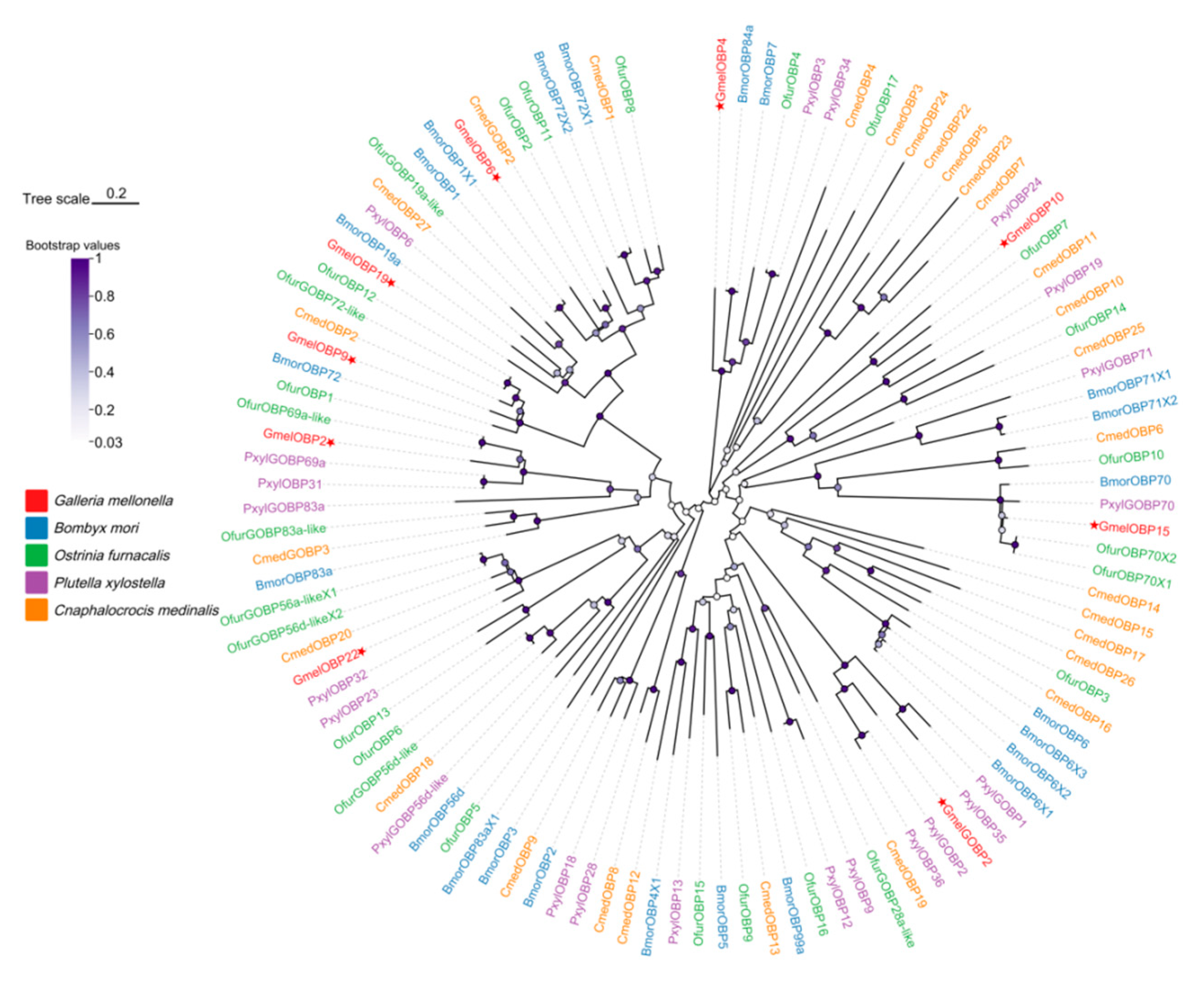

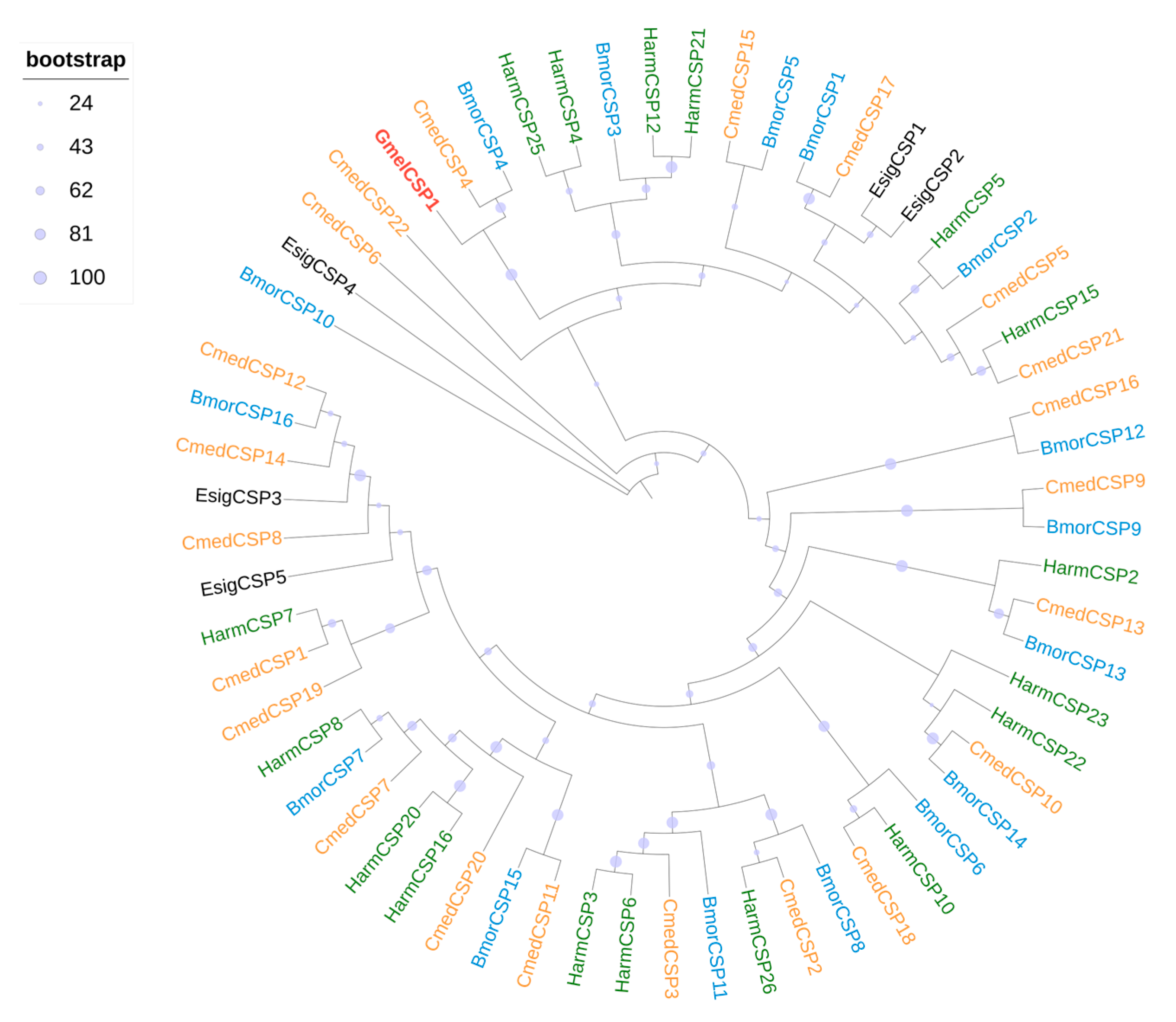
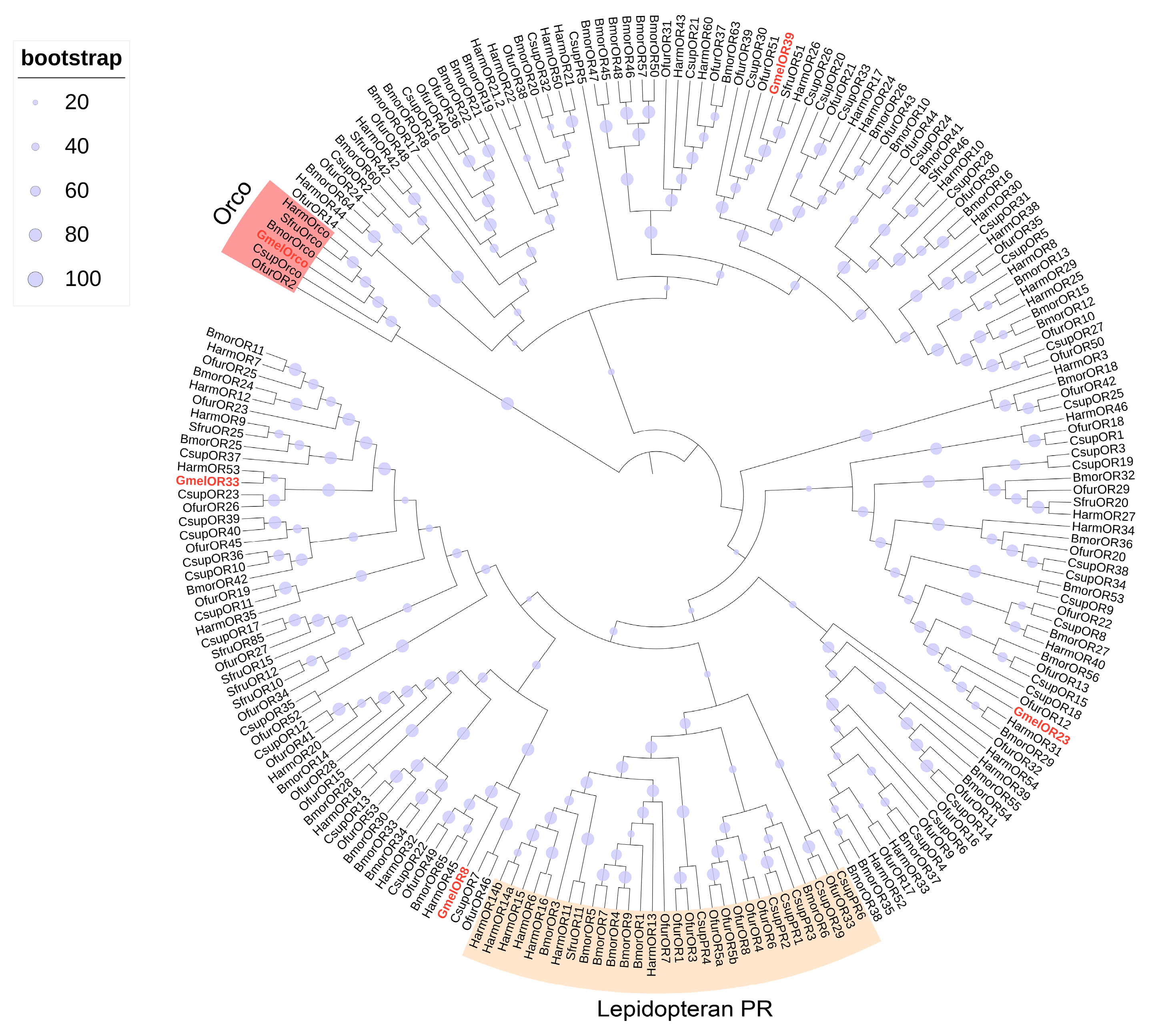
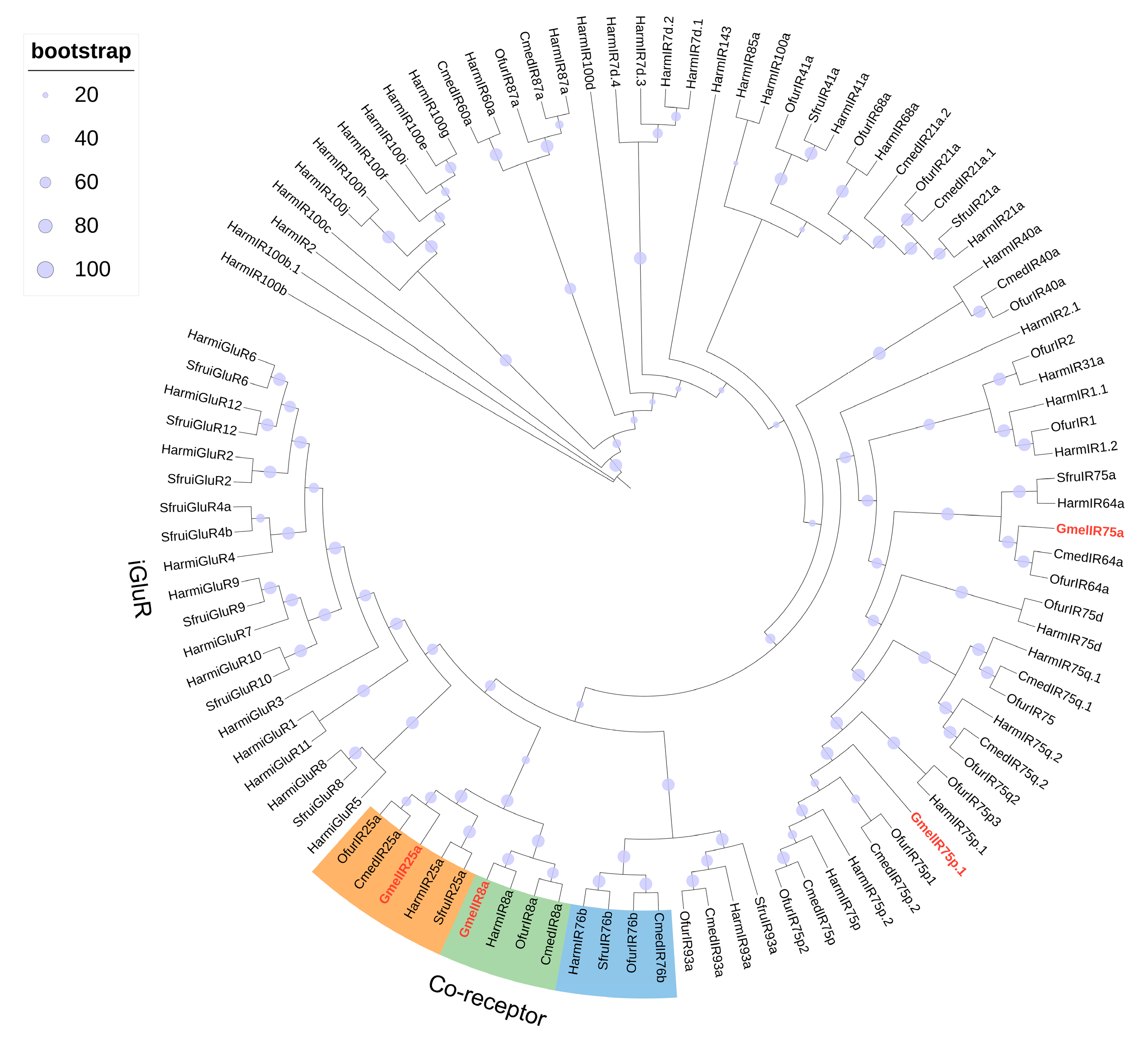
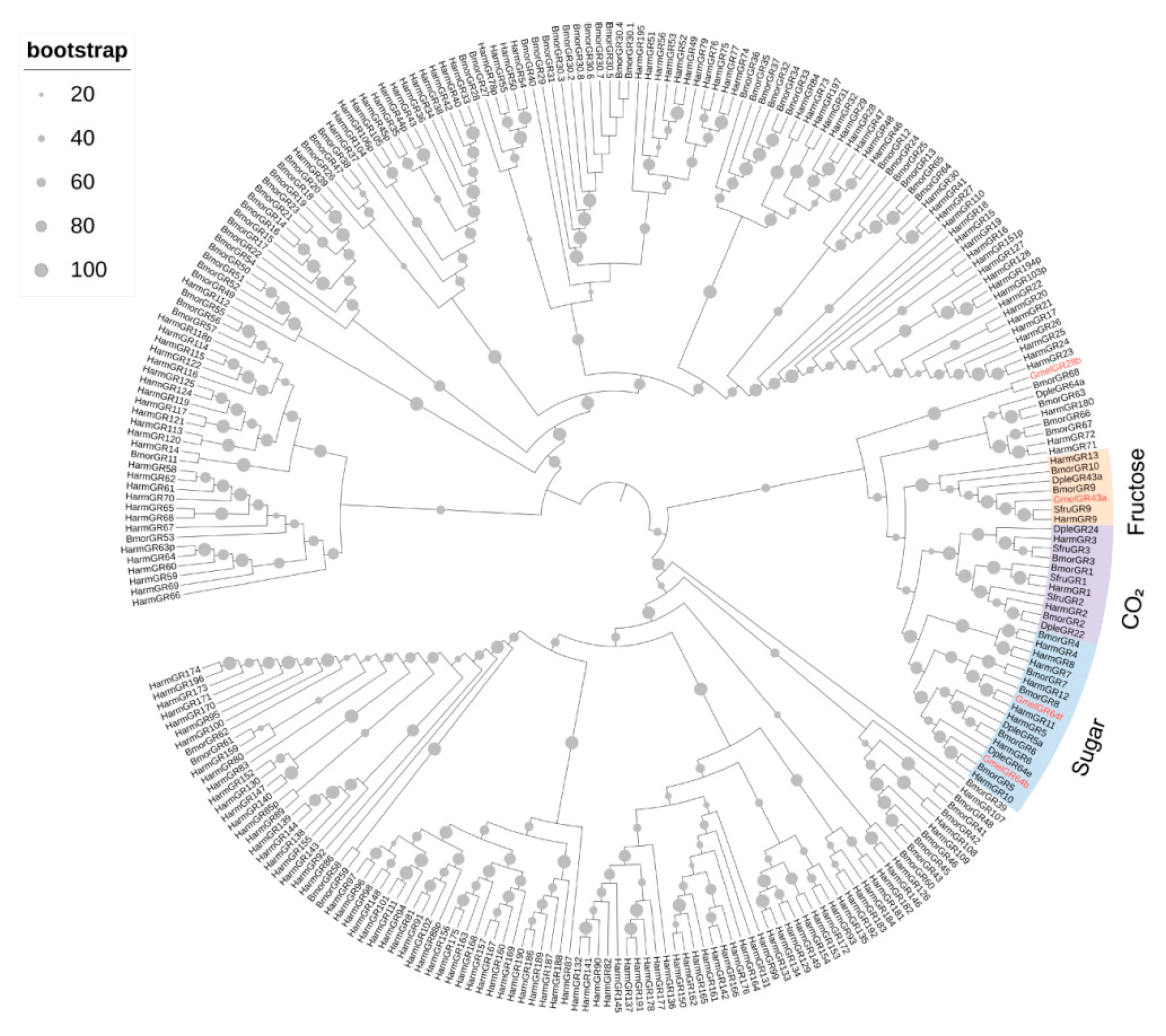


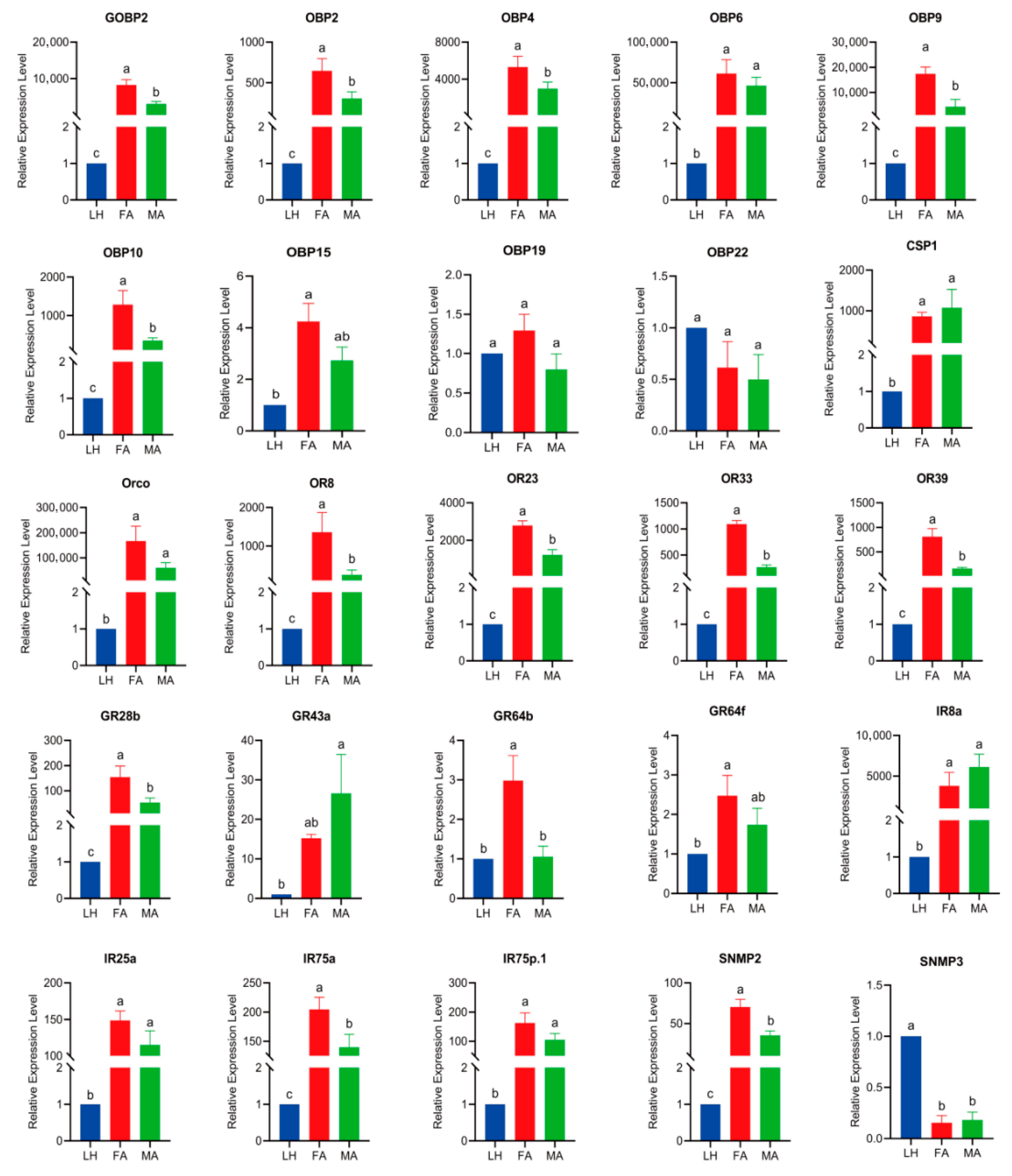
| Sample | Raw Reads | Clean Reads | GC (%) | Mapping to Reference Genome | |||
|---|---|---|---|---|---|---|---|
| Unmapped (%) | Unique_Mapped (%) | Multiple_Mapped (%) | Total_Mapped (%) | ||||
| B1 | 44,519,814 | 44,482,294 | 46.36% | 3,336,545 (7.52%) | 39,951,945 (90.09%) | 1,057,802 (2.39%) | 41,009,747 (92.48%) |
| B2 | 37,798,260 | 37,760,480 | 46.58% | 2,830,137 (7.53%) | 33,642,303 (89.49%) | 1,121,770 (2.98%) | 34,764,073 (92.47%) |
| B3 | 36,716,974 | 36,682,794 | 46.97% | 2,852,072 (7.81%) | 32,505,911 (89.01%) | 1,161,935 (3.18%) | 33,667,846 (92.19%) |
| H1 | 37,663,488 | 37,637,858 | 46.79% | 3,687,983 (9.99%) | 32,329,840 (87.56%) | 903,495 (2.45%) | 33,233,335 (90.01%) |
| H2 | 38,150,846 | 38,126,122 | 45.88% | 3,470,195 (9.15%) | 33,589,272 (88.60%) | 853,085 (2.25%) | 34,442,357 (90.85%) |
| H3 | 38,001,200 | 37,972,426 | 45.80% | 3,317,196 (8.80%) | 33,593,831 (89.12%) | 783,089 (2.08%) | 34,376,920 (91.20%) |
Disclaimer/Publisher’s Note: The statements, opinions and data contained in all publications are solely those of the individual author(s) and contributor(s) and not of MDPI and/or the editor(s). MDPI and/or the editor(s) disclaim responsibility for any injury to people or property resulting from any ideas, methods, instructions or products referred to in the content. |
© 2025 by the authors. Licensee MDPI, Basel, Switzerland. This article is an open access article distributed under the terms and conditions of the Creative Commons Attribution (CC BY) license (https://creativecommons.org/licenses/by/4.0/).
Share and Cite
Xie, J.; Zhang, H.; Li, C.; Sun, L.; Wang, P.; Guo, Y. Transcriptome Analysis and Identification of Chemosensory Genes in the Galleria mellonella Larvae. Insects 2025, 16, 1004. https://doi.org/10.3390/insects16101004
Xie J, Zhang H, Li C, Sun L, Wang P, Guo Y. Transcriptome Analysis and Identification of Chemosensory Genes in the Galleria mellonella Larvae. Insects. 2025; 16(10):1004. https://doi.org/10.3390/insects16101004
Chicago/Turabian StyleXie, Jiaoxin, Huiman Zhang, Chenyang Li, Lele Sun, Peng Wang, and Yuan Guo. 2025. "Transcriptome Analysis and Identification of Chemosensory Genes in the Galleria mellonella Larvae" Insects 16, no. 10: 1004. https://doi.org/10.3390/insects16101004
APA StyleXie, J., Zhang, H., Li, C., Sun, L., Wang, P., & Guo, Y. (2025). Transcriptome Analysis and Identification of Chemosensory Genes in the Galleria mellonella Larvae. Insects, 16(10), 1004. https://doi.org/10.3390/insects16101004





